Sanqing Mountain: Your Ultimate Guide to Exploring China’s Sacred Peaks
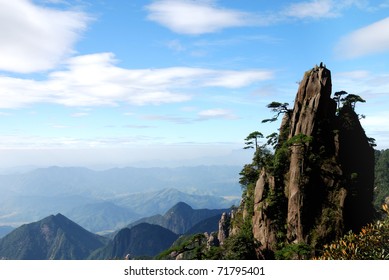
An Essential Guide to Visiting Sanqing Mountain
In This Guide
- An Essential Guide to Visiting Sanqing Mountain
- The Rich History and Legends of Sanqing Mountain
- Main Highlights: What You Absolutely Can’t Miss
- Planning Your Visit: A Practical Guide
- Tickets: Prices, Booking, and Tips
- How to Get There: A Complete Transportation Guide
- Local Cuisine and Accommodation Nearby
- Frequently Asked Questions
- Final Thoughts on Your Trip
Nestled in the heart of Jiangxi Province, Sanqing Mountain (上饶三清山) stands as a testament to the breathtaking beauty and rich cultural heritage of China. A UNESCO World Heritage site, this majestic mountain range captivates visitors with its dramatic granite peaks, lush forests, and vibrant flora and fauna. The area is not just a feast for the eyes; it is also steeped in Taoist history and mythology, making it a pilgrimage site for those seeking spiritual enlightenment and natural wonder.
As you embark on your journey to Sanqing Mountain, prepare to be enthralled by its unique geological formations, including towering cliffs and oddly shaped rocks that seem to defy gravity. The mountain’s name, which translates to “Three Purities,” reflects its significance in Taoism, symbolizing the three fundamental aspects of the universe: heaven, earth, and humanity. This sacred landscape is dotted with ancient temples and shrines, offering a glimpse into the spiritual traditions that have flourished here for centuries.
What to Expect:
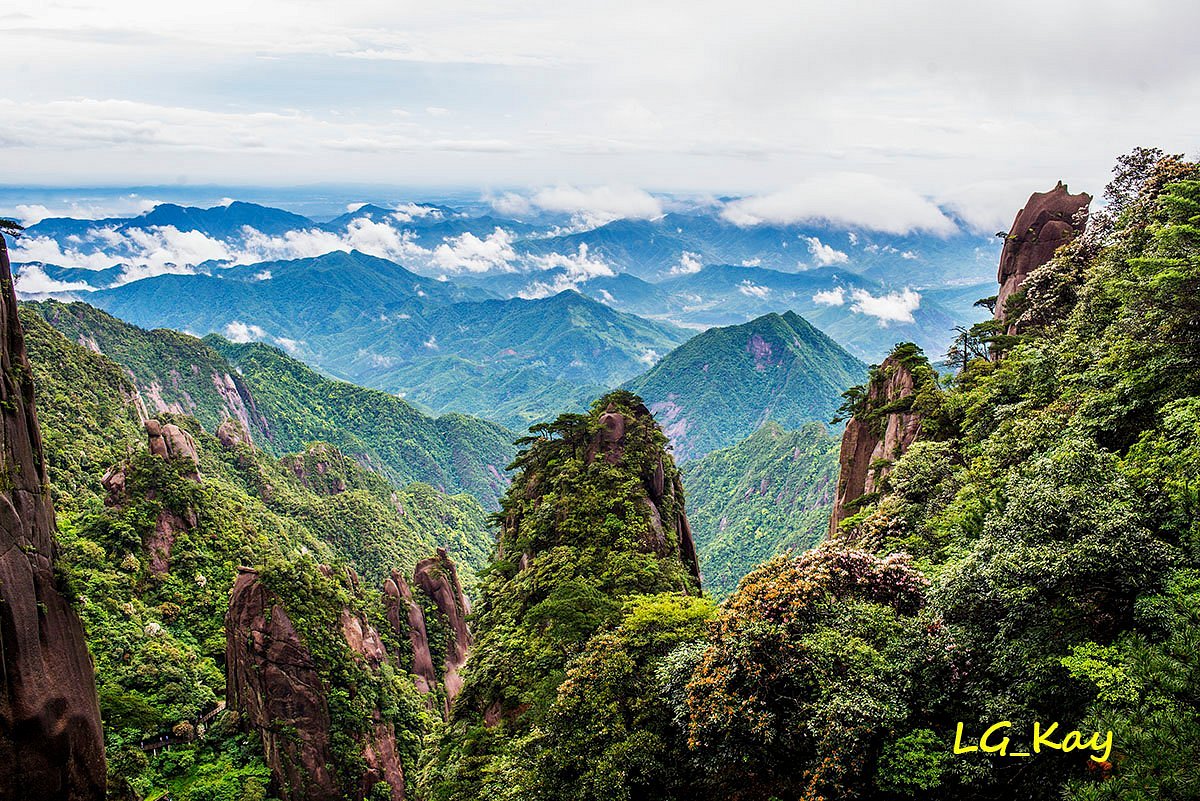
Sanqing Mountain.
-
Stunning Landscapes: From the moment you arrive, be prepared to witness panoramic views that change with the light of day. Morning mists often shroud the peaks, while sunsets bathe the landscape in warm hues, creating picture-perfect moments at every turn.
-
Diverse Trails: Whether you are a seasoned hiker or a casual wanderer, Sanqing Mountain offers a variety of trails suited to all fitness levels. Well-maintained paths and cableways provide access to some of the most breathtaking viewpoints, allowing you to explore the mountain’s beauty at your own pace.
-
Cultural Richness: Engage with the local culture by exploring the mountain’s historical sites. Visit Taoist temples, learn about the legends surrounding the mountain, and experience local cuisine that reflects the flavors of Jiangxi.
-
Wildlife Encounters: Keep an eye out for the diverse wildlife that inhabits the area. From colorful birds to unique plant species, nature lovers will find plenty to marvel at.
Travel Tips:
-
Best Time to Visit: Sanqing Mountain is enchanting year-round, but spring and autumn are particularly spectacular for their mild weather and vibrant foliage.
-
Preparation is Key: While the trails are accessible, it’s wise to come equipped with good hiking shoes, plenty of water, and a translation app if you are not familiar with Chinese.
-
Avoiding Crowds: To fully appreciate the serenity of this majestic site, consider visiting during weekdays or early mornings to dodge the larger tour groups.
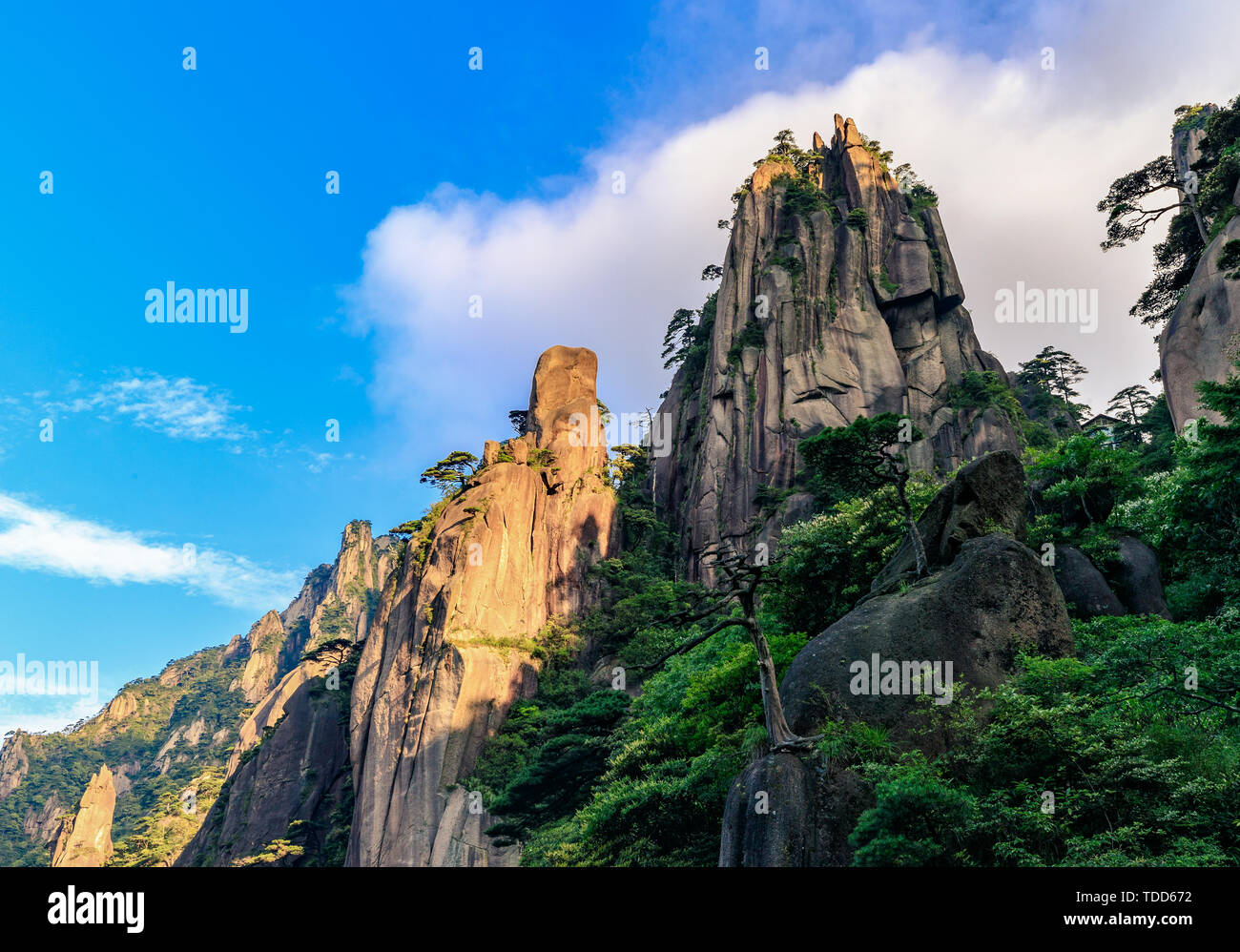
Sanqing Mountain.
As you plan your visit to Sanqing Mountain, let the allure of its natural beauty and rich cultural tapestry inspire you. This destination promises not just a hike through stunning landscapes but a journey through the heart of China’s Taoist heritage.
The Rich History and Legends of Sanqing Mountain
Sanqing Mountain, known as Sanqingshan in Chinese, is not only a breathtaking natural wonder but also a treasure trove of history and legends that echo through its rugged peaks and valleys. Recognized as a UNESCO World Heritage site, this majestic mountain range has been a focal point for Taoist philosophy and spirituality for centuries, embodying the cultural and spiritual essence of China.
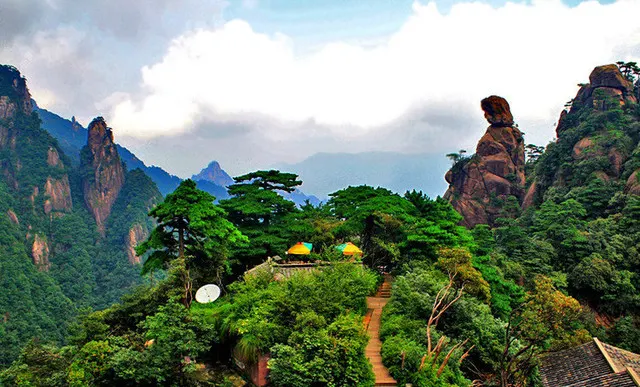
Sanqing Mountain.
Historical Significance
Sanqing Mountain holds a prominent place in Chinese history, particularly in Taoism. It is believed to have been revered as a sacred site since the Tang Dynasty (618-907 AD), serving as a retreat for Taoist monks and scholars. The mountain is named after the Three Pure Ones (Sanqing), the supreme deities of Taoism: Laozi, Zhang Daoling, and Laojun. Each of these figures represents a different aspect of the Taoist belief system, intertwining philosophy, morality, and the pursuit of harmony with nature.
The mountain’s historical significance is further highlighted by the numerous temples and shrines scattered throughout the area, with the Sanqing Temple being one of the most notable. This temple, dedicated to the Three Pure Ones, has attracted pilgrims and visitors for centuries, who come to seek wisdom, blessings, and a deeper understanding of Taoist teachings.
Legends and Myths
Over the years, Sanqing Mountain has inspired a rich tapestry of legends that reflect the beliefs and values of the local culture. Here are some of the most compelling stories associated with this enchanting location:
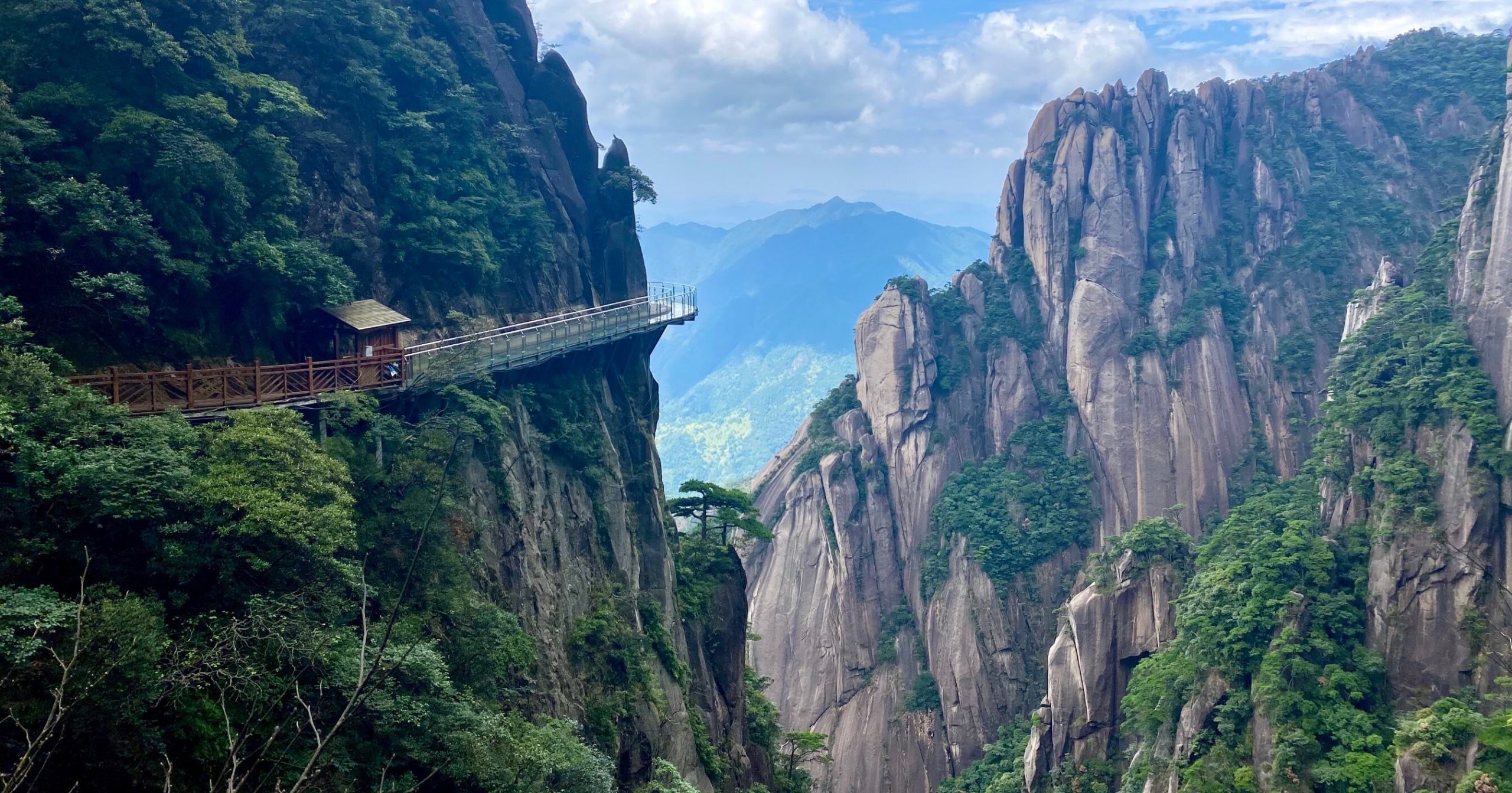
Sanqing Mountain.
-
The Creation of Sanqing Mountain: Legend has it that the mountain was formed from the tears of a distraught goddess who wept for the suffering of humanity. Her cries echoed through the valleys and mountains, creating the stunning rock formations that we see today. This myth underscores the mountain’s connection to the divine and its role as a sanctuary for those seeking solace.
-
The Immortal’s Path: Another popular legend tells the tale of an ancient Taoist immortal who traversed the mountain in search of the secrets to eternal life. It is said that he discovered a hidden cave within the mountain that contained elixirs of immortality. To this day, many hikers believe that if they climb to the mountain’s peak and make a wish, they may receive blessings from the immortal.
-
The Guardian Spirits: Locals believe that the mountain is protected by guardian spirits, often represented by the unique rock formations that dot the landscape. Each formation has its own story, such as the Goddess Peak, which is said to resemble a beautiful woman gazing down upon the land. Visitors often pay homage to these natural sculptures, leaving offerings in hopes of receiving protection and guidance on their journeys.
Cultural Impact
The influence of Sanqing Mountain extends beyond its physical beauty and spiritual significance. It has inspired countless poets, artists, and writers throughout Chinese history. The breathtaking vistas and serene landscapes serve as a backdrop for artistic expression, capturing the essence of nature’s beauty and the human spirit’s quest for enlightenment.
In modern times, Sanqing Mountain continues to attract tourists and pilgrims, both for its stunning natural scenery and its deep-rooted cultural significance. The trails that weave through the mountain offer not only physical challenges but also opportunities for reflection and connection to the ancient wisdom that permeates this sacred site.
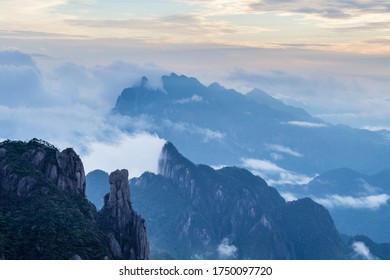
Sanqing Mountain.
Conclusion
Sanqing Mountain is a remarkable destination that encapsulates the rich history and legends of China. From its roots in Taoist philosophy to the enchanting stories that have emerged over the centuries, this majestic mountain serves as a testament to the enduring relationship between nature and spirituality. For international travelers seeking a profound cultural experience, Sanqing Mountain promises not only breathtaking views but also a journey through the heart of Chinese history and legend.
Main Highlights: What You Absolutely Can’t Miss
Sanqing Mountain, or Sanqing Shan, is a breathtaking UNESCO World Heritage site located in Jiangxi Province, China, renowned for its stunning natural beauty and rich cultural history. Whether you’re a seasoned hiker or simply a nature enthusiast, the mountain offers a plethora of highlights that are simply not to be missed. Here’s a detailed guide to the main attractions that will leave you in awe of this magnificent landscape.
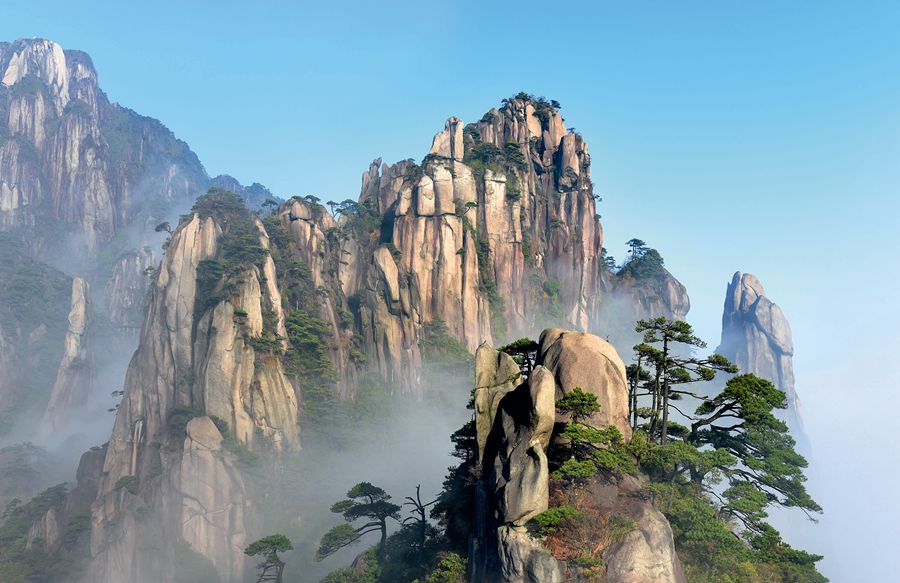
Sanqing Mountain.
1. The Iconic Peaks
Sanqing Peak (三清山):
This is the highest point on the mountain, standing at 1,817 meters. From here, you can enjoy panoramic views of the surrounding landscape. The sunrise from Sanqing Peak is a sight to behold, bathed in hues of gold and orange.
Yunv Peak (云女峰):
Known as the “Cloud Girl,” this peak is famous for its unique rock formations and offers a more tranquil hiking experience away from the crowds. The breathtaking vistas make it a perfect spot for photography.
Linggu Peak (灵谷峰):
This peak is often less crowded and provides stunning views of the valleys below. The lush greenery and serene atmosphere make it an ideal location for reflection and relaxation.

Sanqing Mountain.
2. Stunning Rock Formations
Sanqing Mountain is celebrated for its extraordinary granite formations. Among the most famous are:
- The Giant Boa (巨蟒): This rock formation resembles a giant snake and is a popular photo spot.
- Goddess Rock (女神石): Another must-see formation, this rock is said to resemble a goddess, adding a layer of cultural significance to the natural beauty.
3. Scenic Plankwalks
The mountain features several well-constructed plankwalks, offering both safety and stunning views. The three main loops provide a fantastic way to explore the area without the strenuous climbs:
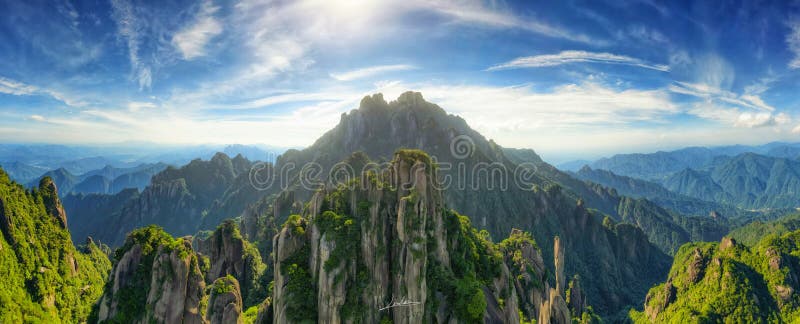
Sanqing Mountain.
- East Loop Plankwalk: This path offers scenic views and unique rock formations while providing a relatively easy hike.
- West Loop Plankwalk: Similar to the East Loop, this route is perfect for those looking to enjoy the natural beauty of the mountain with fewer tourists around.
4. Cultural Sites and Temples
Daode Temple (道德宫):
Nestled among the peaks, this Taoist temple offers insight into the spiritual heritage of the area. The temple’s architecture and serene environment make it a perfect spot for those seeking a quiet retreat.
Yangtang Temple (阳塘寺):
This temple, situated near the base, is an excellent place to learn about local religious practices and enjoy the peaceful surroundings.

Sanqing Mountain.
5. Breathtaking Views and Photography Spots
Every corner of Sanqing Mountain presents an opportunity for stunning photography. Key viewpoints include:
- Jingsha Cableway Station: A popular starting point for many hikers, the views from here are simply spectacular, especially at sunrise or sunset.
- Various Lookouts: Numerous lookout points along the trails allow you to capture the dramatic landscapes, including swirling clouds and distant peaks.
6. Wildlife and Flora
The diverse ecosystem of Sanqing Mountain is home to a variety of wildlife, including rare bird species and unique plant life. Be sure to keep an eye out for these natural wonders as you hike through the forests and rock formations.

Sanqing Mountain.
7. Practical Tips for Visitors
- Best Time to Visit: Spring and autumn are ideal for mild weather and stunning scenery. Summer can be crowded with tourists.
- Stay Hydrated and Prepared: Bring water, snacks, and a good pair of hiking shoes. The trails can be steep and challenging.
- Use Technology Wisely: Download translation apps and maps to help navigate the area, as many signs may not be in English.
Conclusion
Sanqing Mountain is not just a destination; it’s an experience that immerses you in the beauty of nature and the richness of Chinese culture. Whether you’re climbing steep peaks, walking along tranquil plankwalks, or exploring ancient temples, this UNESCO World Heritage site promises memories that will last a lifetime. Don’t miss the chance to discover the magic of Sanqing Mountain on your next adventure!
Planning Your Visit: A Practical Guide
Sanqing Mountain, known as Sanqing Shan (上清山), is a breathtaking UNESCO World Heritage Site located in Shangrao, Jiangxi Province, China. For international travelers keen to explore its rugged beauty and rich cultural heritage, planning your visit to this majestic mountain range will enhance your experience immensely. Here’s a practical guide to ensure a smooth and enjoyable adventure.
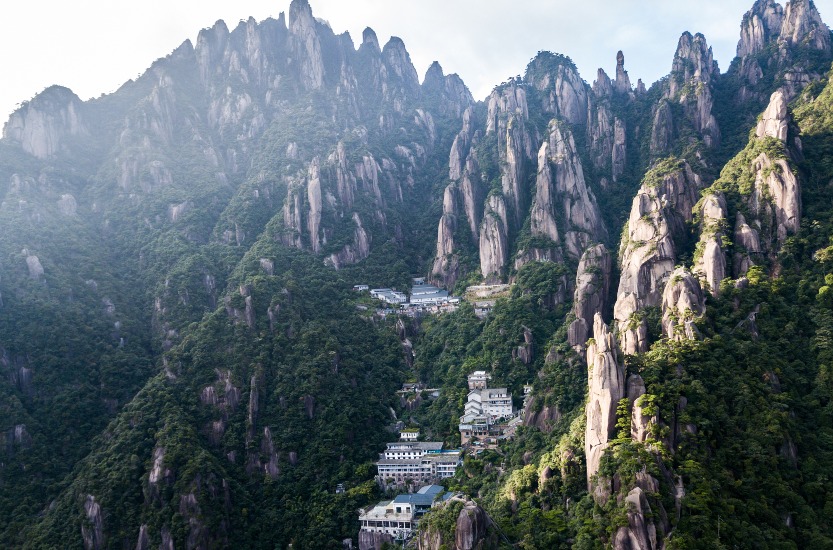
Sanqing Mountain.
Best Time to Visit
The ideal seasons to visit Sanqing Mountain are spring (March to May) and autumn (September to November). During these months, the weather is generally mild, and the landscape is adorned with vibrant flora. Summer can be hot and crowded, while winter, though beautiful with snow, may limit access to some trails and attractions.
Getting There
Sanqing Mountain is conveniently located about 4 hours by high-speed train from major cities like Shanghai and Nanjing. The nearest train station is Shangrao Railway Station. From there, you can take a local bus or taxi to the mountain entrance. It is advisable to check train schedules in advance and consider booking tickets online, especially during peak seasons.
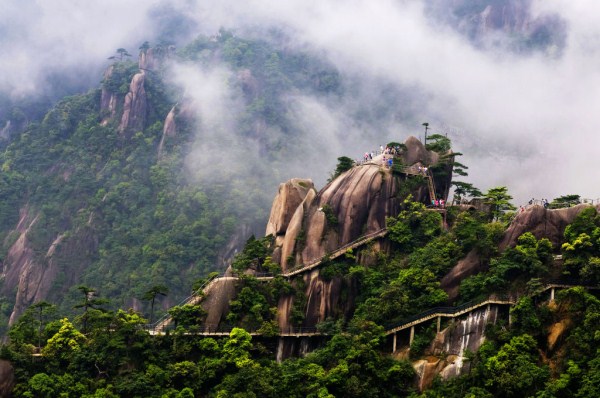
Sanqing Mountain.
Entrance Fees and Hours
- Entrance Fee: Approximately 250 RMB (around $38) for a one-day pass. Multi-day passes may also be available.
- Operating Hours: Daily from 6:00 AM to 8:00 PM.
Accommodation Options
While there are various accommodation options ranging from budget hostels to luxury hotels, consider staying at a hotel near the base of the Waishuangxi cableway for easy access to the mountain. The Hilton Sanqing Mountain Resort is a popular choice, offering comfortable amenities and stunning views.
Exploring the Mountain
Sanqing Mountain boasts numerous trails and scenic spots. Here are some highlights to consider:
Key Attractions
- Cableway Rides: For those looking to save energy, the cableways provide easy access to higher elevations and breathtaking views.
- Plankways: The various plankways offer stunning vistas and are generally less crowded, especially if you start early in the day.
- Notable Peaks: Don’t miss the iconic rock formations and peaks, such as the Giant Boa and Goddess Peak, which are perfect for photography.
Suggested Itinerary
For a comprehensive experience, consider this two-day itinerary:
– Day 1:
– Arrive early and take the cableway to start your hike.
– Explore the eastern plankway, visiting key peaks and enjoying panoramic views.
– Return to your hotel for dinner and rest.
- Day 2:
- Start early again, this time focusing on the western plankway.
- Visit less crowded areas and take your time exploring the natural beauty.
- Wrap up your visit with a trek to any remaining attractions before returning.
Tips for a Successful Visit
- Arrive Early: Beat the crowds by arriving when the park opens. This is particularly important for popular sites.
- Use a Map or App: The provided maps may be in Chinese; consider using a translation app or GPS-enabled hiking apps like AllTrails for navigation.
- Stay Hydrated and Snack Ready: Carry water and snacks, as food options can be limited or overpriced on the mountain.
- Learn Basic Mandarin Phrases: Knowing a few simple phrases can enhance your interactions with locals and fellow travelers.
- Be Patient: Expect crowds, especially near popular attractions. Embrace the experience and take in the vibrant atmosphere.
Cultural Etiquette
As you explore, remember that you are in a culturally rich environment. Here are some etiquette tips:
– Respect Local Customs: Be mindful of loud conversations or disruptive behavior, especially in serene areas.
– Photography Considerations: Always ask for permission before taking photos of individuals, especially in rural areas.
Conclusion
Sanqing Mountain is a gem of natural beauty and cultural significance, offering a unique window into China’s rich heritage. With careful planning and a spirit of adventure, you can make the most of your visit and enjoy the stunning landscapes and serene atmosphere this UNESCO World Heritage Site has to offer. Prepare well, tread lightly, and immerse yourself in the breathtaking beauty of Sanqing Shan. Safe travels!
Tickets: Prices, Booking, and Tips
Exploring Sanqing Mountain: Ticket Information, Booking, and Essential Tips
Sanqing Mountain, a UNESCO World Heritage site, is renowned for its stunning landscapes and rich cultural history. As you plan your visit to this majestic destination, understanding the ticketing process and some handy tips will enhance your experience.
Ticket Prices
- General Admission:
- Adult: Approximately ¥160 (about $23 USD)
-
Discounted rates for children, seniors, and students may apply, so it’s advisable to bring relevant identification.
-
Cableway Tickets:
- Waishuangxi Cableway: ¥80 (about $11 USD) for one way, and ¥120 (about $17 USD) for a round trip.
-
Additional cableways may have different rates, so check at the respective stations.
-
Tour Packages:
- Various tour operators offer packages that include guided hikes, transportation, and meals ranging from ¥500 to ¥650 (about $70 to $90 USD) for multi-day experiences.
Booking Options
- Online Reservations:
-
Tickets can often be purchased via official websites or travel platforms like Trip.com or Ctrip. Booking in advance is recommended during peak seasons.
-
On-Site Purchase:
-
Tickets can also be bought at the entrance. However, be prepared for potential queues, especially on weekends and holidays.
-
Guided Tours:
- Consider joining a guided tour for an enriched experience. Many tours include transportation, a knowledgeable guide, and sometimes even meals.
Essential Tips for Your Visit
- Plan Your Visit:
-
Aim to arrive early, ideally when the park opens at 6:00 AM. This helps you avoid the large crowds typically seen later in the day.
-
Explore Beyond the Crowds:
-
After visiting the main attractions near the cableways, venture into less-traveled areas. The plankways and peaks away from the main routes offer stunning views and quieter experiences.
-
Bring Necessary Gear:
-
Comfortable hiking shoes are a must. Also, consider packing a light jacket, snacks, and water, as some areas have limited food options.
-
Language Considerations:
-
While there is some English signage, it can be sparse. A translation app on your phone can be invaluable for navigating signs and communicating with locals.
-
Cash and Payment Apps:
-
Although some locations accept credit cards, having cash (RMB) on hand is advisable. Popular Chinese payment apps like WeChat Pay and Alipay are widely used, but you may need a local account to use them.
-
Stay Patient and Open-Minded:
- Encountering crowds, particularly during holidays, is common. Embrace the experience, and remember that a friendly smile and basic Chinese phrases can go a long way in enhancing interactions with locals.
By arming yourself with this ticketing information and practical tips, you’ll be well-prepared to enjoy the breathtaking beauty and rich cultural heritage of Sanqing Mountain. Happy hiking!
How to Get There: A Complete Transportation Guide
Getting to Sanqing Mountain: A Comprehensive Transportation Guide
Sanqing Mountain, a UNESCO World Heritage Site, is renowned for its breathtaking landscapes, unique rock formations, and rich cultural history. Accessible from various urban centers in China, reaching this natural wonder requires some planning. Here’s everything you need to know to navigate your way to Sanqing Mountain effectively.
By Air: The Nearest Airports
- Shangrao Sanqingshan Airport (SQD)
- Distance: Approximately 30 kilometers from the mountain.
- Connections: Limited domestic flights primarily connect to major cities like Shanghai and Guangzhou.
-
Transport Options: Taxis and shuttle buses are available at the airport to take you directly to the mountain area.
-
Nanchang Changbei International Airport (KHN)
- Distance: About 150 kilometers away.
- Connections: A larger airport with more international and domestic flights.
- Transport Options: From here, you can take a train or bus to Shangrao, followed by a taxi or bus to Sanqing Mountain.
By Train: A Scenic Journey
High-Speed Train Services
– Departure Cities: High-speed trains to Shangrao are available from major cities like Shanghai, Nanchang, and Hangzhou.
– Duration: The journey can take anywhere from 2 to 5 hours, depending on your starting point.
– Arrival Station: Shangrao Railway Station is the closest major train station to Sanqing Mountain.
After arriving at Shangrao Railway Station:
– Buses: Direct buses to the Sanqing Mountain Scenic Area operate regularly, taking about an hour.
– Taxis: Available outside the station, providing a quicker, albeit more expensive, option.
By Bus: Local Convenience
For those already traveling within Jiangxi Province:
– Long-Distance Buses: Multiple bus services run to Shangrao from cities like Nanchang, Jiujiang, and even nearby provinces.
– Local Buses: Once in Shangrao, local buses are available to take you to the Sanqing Mountain Scenic Area. The journey typically lasts around one hour.
By Car: Flexible Exploration
Self-Driving or Ride-Hailing
– Rental Cars: Available in major cities, offering the flexibility to explore at your own pace. The drive from Shangrao to Sanqing Mountain takes about an hour.
– Ride-Hailing Services: Apps like Didi or local taxis can be used to reach the mountain directly.
Getting Around Sanqing Mountain
Once you arrive at Sanqing Mountain, the transport options for exploring the area include:
- Cable Cars: A scenic and efficient way to ascend the mountain. The Waishuangxi cableway offers access to various viewpoints and hiking trails.
- Walking Trails: Well-maintained paths wind through the park, but be prepared for a fair amount of hiking. The trails are clearly marked, though signage may be primarily in Chinese.
- Guided Tours: Consider joining a guided tour for an enriched experience, as guides can provide valuable insights into the area’s history and culture.
Tips for a Smooth Journey
- Plan Ahead: Check train and bus schedules in advance, especially during peak tourist seasons.
- Language Barrier: While some signs are bilingual, many are not. Consider downloading translation apps or having key phrases handy to ease navigation.
- Travel Light: If you plan to hike, pack essentials but keep your load manageable.
Reaching Sanqing Mountain is a rewarding adventure in itself, paving the way for breathtaking views and cultural enrichment. Whether you choose to travel by air, train, or bus, each method offers its own unique perspective on the beauty of this incredible destination.
Local Cuisine and Accommodation Nearby
When embarking on a journey to Sanqing Mountain, not only will you be enchanted by its breathtaking landscapes and rich cultural heritage, but you will also have the opportunity to indulge in local delicacies and find comfortable accommodations nearby.
Savory Delights to Savor
1. Local Cuisine Overview
Sanqing Mountain is nestled in Jiangxi Province, renowned for its unique dialect and culinary traditions. Local fare often reflects the region’s natural bounty and agricultural practices, showcasing an array of fresh ingredients and bold flavors.
2. Must-Try Dishes
– Sanqing Fish (三清鱼): This dish features fish caught from the mountain streams, often stir-fried with local vegetables. Its freshness and subtle flavors are a must for any visitor.
– Jiangxi Rice Noodles (江西米粉): These thin rice noodles are a staple in Jiangxi cuisine and are often served in a fragrant broth with various toppings such as pickled vegetables and meats.
– Bamboo Shoots (竹笋): Harvested from the surrounding bamboo groves, these tender shoots are commonly used in stir-fries and soups, offering a crunchy texture and earthy flavor.
– Stir-Fried Mountain Vegetables (山野菜): For a taste of the wild, try the seasonal mountain vegetables, which are typically sautéed with garlic and served as a side dish.
3. Dining Recommendations
– Sanqing Mountain Restaurant (三清山餐厅): Located at the base of the mountain, this restaurant specializes in local dishes and provides a cozy atmosphere. Guests rave about the Sanqing Fish and the various vegetable dishes.
– Shan Hu Restaurant (山湖餐馆): Situated in the nearby town of Shangrao, this eatery offers a mix of traditional Jiangxi cuisine and modern twists. The ambiance is warm and welcoming, perfect for unwinding after a day of hiking.
Comfortable Stays for Every Traveler
1. Accommodation Options
Whether you prefer a luxurious retreat or a cozy inn, there are several options to ensure a restful stay near Sanqing Mountain.
2. Recommended Hotels
– Hilton Sanqing Mountain Resort: This upscale hotel is conveniently located near the Waishuangxi cableway, providing easy access to the mountain. With modern amenities, an on-site restaurant serving local and international cuisine, and stunning views of the surrounding landscape, it’s an ideal choice for comfort-seeking travelers.
-
Sanqing Mountain Scenic Area Hotel (三清山风景区宾馆): A mid-range option situated within the scenic area, this hotel offers simple yet comfortable accommodations. It’s an excellent base for those looking to explore the mountain trails early in the morning before the crowds arrive.
-
Xiyuan Inn (溪源客栈): For those seeking a more authentic experience, this charming inn offers traditional guesthouse-style lodging. The owners are known for their hospitality and can provide travelers with insights into local culture, and the inn serves homemade meals featuring local ingredients.
Conclusion
A visit to Sanqing Mountain is not just a feast for the eyes but also a treat for the palate. With a rich selection of local dishes and comfortable accommodations nearby, you can immerse yourself in the beauty of this UNESCO World Heritage site while savoring the flavors of Jiangxi Province. Make sure to indulge in the culinary delights and restful stays that will elevate your travel experience in this stunning region of China.
Frequently Asked Questions
Frequently Asked Questions about Sanqing Mountain
1. What is Sanqing Mountain known for?
Sanqing Mountain, a UNESCO World Heritage site, is renowned for its stunning granite peaks, unique rock formations, lush forests, and rich Taoist cultural heritage. The area offers breathtaking vistas, making it a paradise for hikers and nature lovers.
2. How do I get to Sanqing Mountain?
Sanqing Mountain is accessible from Shangrao City, which is approximately a 1.5-hour drive away. You can take high-speed trains to Shangrao from major cities like Shanghai or Hangzhou, followed by a bus or taxi to the mountain entrance.
3. What is the best time to visit Sanqing Mountain?
The ideal times to visit are spring (April to June) and autumn (September to November) when the weather is mild and the scenery is at its most vibrant. Summer can be crowded with tourists, while winter offers a serene, snowy landscape but may have limited access to certain trails.
4. Are there accommodations available near Sanqing Mountain?
Yes, there are various accommodation options ranging from budget hostels to luxury hotels near the mountain base. Staying overnight allows you to explore the area early in the morning or late in the day to avoid the crowds.
5. What hiking options are available?
Sanqing Mountain has trails suitable for all fitness levels, including well-maintained plankways and more challenging routes. You can opt for a leisurely walk or a strenuous hike up the peaks. Many visitors recommend taking the cable cars to save time and energy for exploring the higher trails.
6. Is it necessary to speak Chinese to visit?
While some signage is available in English, it’s beneficial to learn a few basic phrases in Chinese or use translation apps. Many visitors find that knowing how to say “thank you” and “excuse me” can enhance their interactions with locals.
7. What should I bring with me for a day hike?
Essentials include comfortable hiking shoes, water, snacks, a map (or GPS-enabled app), sunscreen, and a light jacket. If you’re not accustomed to large crowds, consider bringing earplugs for a more peaceful experience.
8. Are there any specific cultural practices I should be aware of?
Respect local customs, especially in this culturally significant area. Be mindful of noise levels, avoid smoking in public spaces, and be patient with fellow hikers. A friendly smile and a simple greeting in Chinese can go a long way in fostering positive interactions.
Final Thoughts on Your Trip
Embrace the Enchantment of Sanqing Mountain
As you reflect on your journey through the majestic Sanqing Mountain, let the echoes of its breathtaking landscapes and rich cultural heritage resonate within you. This UNESCO World Heritage site is not just a feast for the eyes; it’s a vibrant tapestry woven from the threads of nature and history.
A Journey of Discovery
Each step along the well-maintained paths unveils a new marvel—towering rock formations that seem to touch the heavens, serene temples that whisper tales of ancient Taoist wisdom, and lush forests alive with the songs of birds. Whether you chose to hike or glide on the cableways, you became part of a timeless narrative, where the mountains tell stories of resilience and beauty.
Moments to Cherish
Consider the inspiring encounters you had along the trails, perhaps with fellow travelers or the locals who welcomed you warmly. These shared experiences foster connections that transcend borders, uniting us all in our love for exploration. Remember the laughter, the challenges, and the quiet moments of solitude amidst the grandeur of nature.
Tips for Future Adventurers
For those yet to embark on this adventure, heed the wisdom of travelers before you: rise early to beat the crowds, embrace the local culture, and prepare for the unexpected. Equip yourself with a translation app and an open heart, ready to engage with the vibrant tapestry of Chinese culture that surrounds you.
A Lasting Impression
Sanqing Mountain is more than a destination; it’s an experience that lingers long after you’ve returned home. It invites you to carry its spirit within you, reminding you of the beauty that lies in both the journey and the destination.
As you close this chapter of your travels, remember that the world is vast and filled with wonders waiting to be discovered. May the essence of Sanqing Mountain inspire your next adventure, wherever it may lead. Safe travels! 🌄✈️